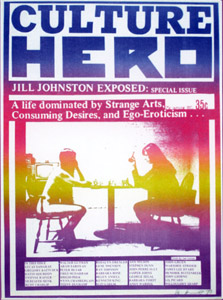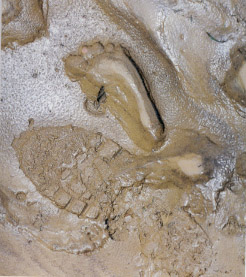








Exhibitions - Fall 2001
October 6 |
Passion, Justice, Freedom |
October 6 |
Stars of the Super World Masterprint “Jill Johnston Exposed” |
| October 15 - December 7 |
The George and Helen Spelvin Folk Art Collection |
| October 15 - December 7 |
Coca-Colonization and Cultural Conservation: Globalization, Sustainable Development, and Empowerment in Nepal
|
Letizia Battaglia:
Passion, Justice, Freedom
Photographs of Sicily
- August 27 - October 6, 2001

Rosaria Schifani, the widow of the bodyguard Vito Schifani
who was assassinated with Judge Giovanni Falcone
and other colleagues in 1992, Palermo, 1993
Letizia Battaglia’s work demonstrates photography’s power to serve as both a weapon and a voice for the people. After years of risking her own life to fight for her troubled city of Palermo—as photographer, publisher, deputy councilwoman, ecological activist, defender of women’s rights, defender of human rights-she continues her battle with passion, intelligence, and vision. Yet she is not motivated by hatred, but rather compassion and a profound sense of justice and freedom. “Freedom,” says Battaglia, “is something priceless, extraordinary.... I have always felt I had the right to my freedom. I have lived all the years of my life with this idea.”
In the first comprehensive exhibition of her work, Battaglia juxtaposes candid pictures of the everyday joy, suffering, and vitality of her fellow Sicilians with images depicting the effects of Mafia predators who for so long controlled much of the island’s political and economic life. “Corpses in the night, mothers doubled up in pain; for years, Letizia Battaglia’s shots have been like combat weapons,” as stated in Paris’ L’Express.
“I took pictures of everything. Suddenly I had an archive of blood. An archive of pain, of desperation, of terror, of young people on drugs, of young widows, of trials and arrests.... It was like being in the middle of a revolution,” says the W. Eugene Smith award-winning Battaglia, who has worked for over twenty years as director of photography for the left-wing daily, L’Ora. New York’s Newsday calls her work “a stark indictment of life and death under the Mafia,” and according to London’s Telegraph Magazine, “the photographs hint not only at the moral extremes of black and white, and life and death, but at the resolute determination of Sicilians.”

Organized by Aperture Foundation in New York, the exhibition premiered at Visa pour l’image in Perpignan, France before traveling to Museo Diego Aragona Pignatelli Cortes di Napoli in Italy and then to Palermo, Sicily, where it was presented at Galleria Bianca at the Cantieri Culturali alla Zisa, organized as part of the Novecento Festiva and in conjunction with a United Nations conference on transnational crime. The show also traveled to Huis Marseille in the Netherlands. The United States tour opens at St. Lawrence University before traveling to Aperture’s Burden Gallery in New York City.
The exhibition features 56 black and white prints with text panels in Italian and English. An accompanying publication is comprised of over 100 photographs and essays by Roberto Scarpinato, Leoluca Orlando, Alexander Stille, Renate Siebert, Simona Mafai, and Melissa Harris, the book’s editor, with co-editions in French, Italian, and German.
Founded in 1952 by Ansel Adams, Dorothea Lange, Barbara Morgan, Beaumont and Nancy Newhall, and Minor White, among others, Aperture is a not-for-profit public foundation devoted to photography and related visual arts. Programs include a quarterly magazine, book publishing, traveling exhibitions, the Paul Strand Archive, and research. Aperture will celebrate its 50th anniversary in 2002.
Culture Hero: A Fanzine of Stars of the Super World
Masterprint “Jill Johnston Exposed”
- August 27 - October 6, 2001

Gift of Robert Steinberg through the
Martin S. Ackerman Foundation, SLU 80.107
In 1969-70, Les Levine published four issues of Culture Hero, a newsprint tabloid devoted to “looking in on the cultural hotshots of the moment.” Number 3, “Jill Johnston Exposed,” was reissued in a special large-format edition as Masterprint and includes interviews, articles, poems, drawings and letters by Gregory Battcock, Suzi Gablik, Jasper Johns, Meredith Monk, Lucas Samaras, Andy Warhol and others. This hallway exhibition includes 28 lithographs that document the New York art scene at the time, and it serves as a counterpoint to the photographs of Sicily taken during the same period.
The George and Helen Spelvin Folk Art Collection
- October 15 - December 7, 2001
- Related Educational Programs

acrylic on Masonite, 25 x 17 inches
The Richard F. Brush Art Gallery is pleased to present the George and Helen Spelvin Folk Art Collection, considered to be one of the most insightful private collections of contemporary “outsider” art. Comprised of more than 900 art objects, the collection was donated in 1997 to the Hokes Archives at the University of Tennessee, Knoxville, to “serve as a creative resource for research and teaching.” A national touring exhibition was organized by Beauvais Lyons, Director of the Hokes Archives and an Ellen McClung Berry Professor of Art.
The exhibition surveys the work of eleven artists, with examples including enamel painted records by Lucas Farley; Arthur Middleton’s painted portraits of American presidents; numerous “limberjack” puppets by Lester Dowdey; velvet paintings of brides by Charlotte Black; flower paintings on book pages by Emma Whorley; and some of the best examples of “mug jugs” by North Carolina potter Rufus Martinez. E.B. Hazzard’s “alien communication device,” made of over 300 hundred flattened tin cans on a modified tent pole structure, and Max Pritchard’s hand-printed religious tracts on cereal boxes are also included in the exhibition, as is the interracial rag doll friendship chain by Loretta Howard, whose grandfather was a member of the Ku Klux Klan.
Over the past twenty-five years, when they were not busy with their jobs as an insurance agent and a school teacher, George and Helen Spelvin have devoted their energy to the study and collection of visionary folk art. While a small number of works have been loaned to museums, including the Smithsonian Institution and the Erie Museum of Art, no comprehensive public showing of the collection has ever been organized. First presented at Carnegie Mellon University in the spring of 2001, the exhibition is currently on a national tour.
In 1994, Beauvais Lyons curated “Rare Discoveries from the Hokes Archives” for the Richard F. Brush Art Gallery, an exhibition of archaeological artifacts, relics, reconstructions, and scientific depictions of never-lived peoples such as the Aazud, the Apasht, and the Arenot. Known for such parodies of anthropological display, Lyons continues to question the authority of the museum and the credibility of biography through the presentation of the George and Helen Spelvin Folk Art Collection. For more information on the Spelvin Collection, as well as the Hokes Archives, visit web.utk.edu/~blyons.
Coca-Colonization and Cultural Conservation:
Globalization, Sustainable Development,
and Empowerment in Nepal
Papermaking by Lydia Brown ‘03
Photographs by Matt Gaines ‘04
- October 15 - December 7, 2001
- Related Educational Programs

In this hallway exhibition, two St. Lawrence students present work from two very different projects that sent them to Nepal in the summer of 2001. For a St. Lawrence University Fellows project, Lydia Brown studied Himalayan papermaking as a means of cultural conservation and sustainable development. She writes, “While in Nepal, I learned how papermaking and paper crafts have become a catalyst for the empowerment of women,” providing jobs, income, and a certain level of independence for many in local communities. At the Nepal Creative Women’s Craft and at Himalayan Paperworks in Kathmandu, Brown studied the harvesting and preparation of daphne fiber and made traditional lokta paper. She also examined the uses of paper, from commercial goods produced primarily for export to its religious functions in Tibetan Buddhist and Hindu contexts.

Matt Gaines became the photojournalist among the St. Lawrence group that traveled to Nepal as part of a Summerterm course entitled “The Personal and the Planetary: An Enlightened Interface.” He focused on environmental studies and the effects of globalization and Westernization in third world countries. Many of his images present ironic commentary on the presence of Western popular culture—posters of Britney Spears and the ubiquitous Coca-Cola signage—in one of the world’s poorest nations. He will include approximately 25 photographs with selected text panels based on his research for the course. For example:
- “Since 1940, Americans alone have used up as large a share of the earth’s mineral resources as all previous generations put together. The typical American discards nearly a ton of trash per year. The United States is the largest consumer of energy in the world-using five times more than the global average.1 [Less than] twenty-five percent of the population consumes [over] seventy-five percent of the world’s natural resources.”2
…Just beside the fourteen-inch imprint of my Vibram-soled leather hiking boot was the tiny footprint of a young child. I found this image particularly powerful and interpreted it as a representation of the ecological footprint that each person has on the globe.

“In the time it takes you to read this sentence, another 100,000 people worldwide will reach for a Coca-Cola soft drink.”3 …One of the first things that struck me about Kathmandu was the proliferation of signs, billboards, street umbrellas, and other manifestations of the gargantuan transnational conglomerate throughout the city. Quite rapidly, however, I grew resentful of the fact that it was impossible to shoot some photographs without the Coca-Cola sign. Nevertheless, the alignment of two different billboards which left “Coca-Cola” situated directly above the word “Empire” was simultaneously disconcerting and ironically hilarious.
-Matt Gaines
1 Dorothy L. Mammen. “Unplug America.” 11 Oct. 1995 http://dis.cs.umass.edu/~mammen/unplug.html.
2“Population Growth and Over-Consumption.” The World Conservation Union. http://www.iucn.org/bil/overpop.html.
3CokeSpotlight. Coca-Cola Challenge Campaign. http://www.cokespotlight.org/flash/indexflash.html.
The Richard F. Brush Art Gallery will be closed from November 17 through November 26 for Thanksgiving break.
We welcome individuals and tours for guided tours of the exhibitions and the University’s permanent collection of nearly 7,000 art objects and artifacts. Many visiting artists and curators are available for class visits by scheduling in advance. Please contact Gallery staff for more information.
Gallery hours Monday-Thursday
Friday and Saturday12-8 p.m.
12-5 p.m.
Catherine Tedford, Director 229-5174 ctedford@stlawu.edu Carole Mathey, Assistant Director 229-5522 cmathey@stlawu.edu